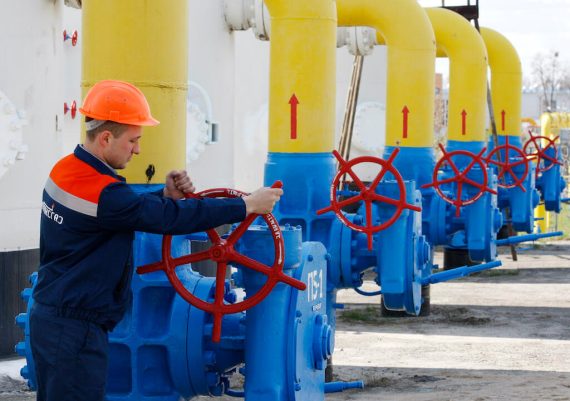Oil has been fueling the world’s economy for about a century while coal is still widely used across the globe. Together with natural gas, fossil fuels constitute more than 80% of the global energy supply. Every single country depends on oil at least to fuel its vehicles. Even though natural gas is not as commonly used as oil and coal, in 2020, it generated about 24% of the global electricity supply while coal generated 35%. However, only a limited number of states dominate the world’s fossil fuel supply, and each uses its energy resources differently.
Russia as a fossil fuel giant
For more than three decades, Russia has been one of the world’s top oil, natural gas, and coal producers and exporters. The primary destinations for Russian energy resources are European countries, led by Germany, Italy, and France. Though Russia is the only gas supplier for many Eastern European countries, its energy share in Germany makes the country the most dependent on Russian natural gas. Germany receives 19% of Russia’s total gas exports. Germany is Russia’s number one importer of oil, oil products, and coal. Not surprisingly, this affects Germany’s and other European states’ foreign policy towards Russia.
When Putin’s army annexed Crimea in 2014, European leaders declared the move unacceptable. Nevertheless, their economies’ dependency on Russian energy resources prevented them from taking any deterring action. The EU imposed a number of sanctions targeting the energy sector but could not prohibit the import of oil, gas, or coal. At the same time, Russia threatened to halt gas flows in response to the sanctions.
However, Putin continued to export energy commodities to Berlin, and Germany went ahead with the construction of the Nord Stream 2 Natural Gas Pipeline, which has long been at the heart of the harsh criticism of Germany by U.S. and European leaders. Russia had planned for the new pipeline to replace the ones passing through Ukraine. But the EU insisted on keeping the gas pipelines via Ukraine flowing and paved the way for a Russia-Ukraine deal. Now, the EU is importing gas through Ukraine and the Nord Stream 2 pipeline project has been suspended.
Turkey is another top recipient of Russian gas, which has the largest share in Turkey’s annual gas imports. Russia also exports crude oil and oil products to Turkey, and its national nuclear power company, Rosatom, is building Turkey’s first nuclear power plant. Yet, in 2015, when the Turkish military shot down a Russian war jet after it violated its airspace, and following the assassination of Russian ambassador to Ankara Andrei Karlov at an art exhibition in Turkey’s capital, Russia did not halt gas flows to Turkey nor did it suspend the Akkuyu Nuclear Power project.
It’s clear that there is an interdependence both between Russia and the EU, and Turkey and Russia. European countries and Turkey need Russian gas and are not able to replace it in the short term. At the same time, Russia also needs to sell its gas in order to generate income. Moscow cannot replace and does not want to lose the European market, which constitutes approximately 75% of its gas, 50% of its oil, and 30% of its coal exports. In conclusion, both sides need their energy trade to continue. The collaboration between the two continues today, and Russia still Turkey’s top energy partner.
The U.S. turns from a net energy importer to a net energy exporter
The United States is one of the most outstanding countries among today’s oil and gas suppliers. Between 1900 and 1976, the U.S. was the world’s top oil producer. However, as oil consumption increased with rising economic activity, and the OPEC (Organization of the Petroleum Exporting Countries) imposed an oil embargo on the U.S. and its allies in 1973, the U.S. Congress passed a law banning oil exports in 1975, so that the U.S. could at least become self-sufficient. The law was valid for 30 years and during this time, the U.S. became a net oil importer because of its rising demand. The ban could be abolished only after the Shale Revolution which enabled hydrocarbon production to rise again.
Hydraulic fracturing and horizontal drilling technology enabled the U.S. to produce oil and gas from shale formations, and in a couple of years, it once again became one of the top hydrocarbon producers. As a result, in 2015, Washington began to pay more attention to exporting energy resources as President Obama lifted the ban on oil exports. In the next year, the country began to export its oil again and shipped its first LNG.
Since then, the U.S. is competing with Russia to have a larger share in the European market. This policy became clearly evident during President Trump’s term. Under the Trump administration, Russia was listed among CAATSA states and Trump criticized European leaders—again and again—because of their huge gas imports from Russia. He pursued an “LNG diplomacy” and called American LNG “freedom gas.” Trump even pushed Germany to construct an LNG regasification terminal in order to import American LNG.
Since the beginning of the Ukraine war, U.S. pressure on Europe continues while the U.S. administration encourages its domestic gas sector to increase its export capacity. The U.S. is now the third-largest LNG exporter after Australia and Qatar, and is aiming to become number one by 2030.
Qatar’s endless quest to be an LNG power
As the technological developments enabled natural gas producers to export their commodities overseas, Qatar has been one of the countries wisely using this opportunity to expand its share in the global gas market. Although natural gas has been liquefied since the 1960s, it became more popular as demand increased across countries. Economic developments in emerging states have played a significant role in this expansion.
As the Ukraine war pushed European countries to shift away from Russian gas, leaders began to look for new suppliers. But importing gas through new pipelines would take at least 3-5 years. In the short term, increasing the LNG supply is the only way for Europe to slash its imports from Russia, and Qatar is one of the countries from which the EU wants to import more gas.
Recommended
Even though the Gulf state claims it wants to export greater quantities of gas to Europe, most of its long-term gas contracts are held by Asian countries such as Japan, South Korea, and China, which cover more than 70% of Qatar’s annual gas exports. Moreover, the U.S. and Australia have been expanding their production of gas. Overall, it does not seem possible for Qatar to export more gas to Europe to replace Russian gas imports. In order for Qatar to expand its share in the global gas market, it needs to invest more in the upstream sector.
Energy as a weapon or a means of collaboration?
The Ukraine war has reminded world leaders of the significance of the energy supply’s security. Russia, the U.S., and Qatar, as countries affecting economies by directly exporting energy commodities, have drawn the most attention recently. While Russia sometimes barks but does not bite, the U.S. oppressively uses its power to suffocate its ultimate rival (see Russia), and Qatar is trying to play the role of a lifeguard.
However, it is evident that exporters are dependent on each other just as exporters and importers are interdependent. Russia needs the EU and Turkey in order to generate income, and the U.S. needs a greater share in the European market to weaken its rival. However, the oil and gas market is global and one player’s loss is felt across the board. Witnessing the Western sanctions’ effect on rising energy prices, the U.S. and Qatar need Russian oil and gas to continue to flow to decrease the repercussions felt by their citizens.





